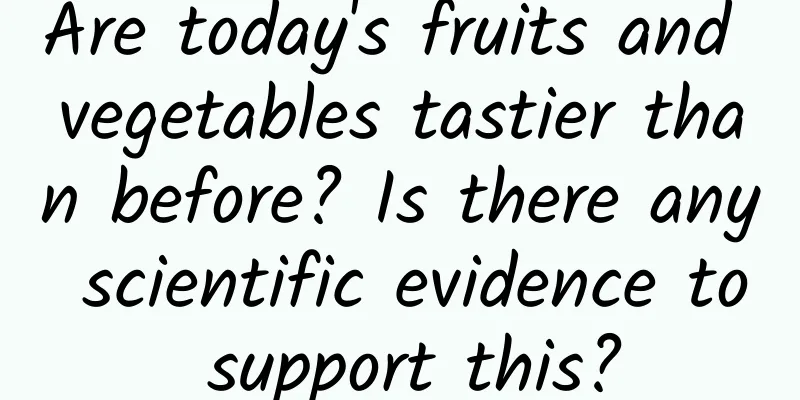Are today's fruits and vegetables tastier than before? Is there any scientific evidence to support this?

|
Image source: Giphy When you look at the rows of brightly colored fruits and vegetables in the supermarket, you might not realize that the nutrient content of these crops has been declining over the past 70 years. Growing evidence from multiple scientific studies suggests that many fruits, vegetables, and grains grown today contain less protein, calcium, phosphorus, iron, vitamin B2, and vitamin C than they did decades ago. In an article published in the Journal of the American College of Nutrition in December 2004, scientists used nutrition data released by the U.S. Department of Agriculture between 1950 and 1999. Researchers at the University of Texas at Austin noticed that 13 nutrients in 43 different fruits and vegetables, such as asparagus, beans, strawberries and watermelon, had changed. Compared with the past, the protein, calcium, phosphorus, iron, vitamin B2 and ascorbic acid content of today's fruits and vegetables have all declined. Comparing the medians, the decline varies. For example, protein has decreased by 6%, and vitamin B2 has decreased by 38%, which is the largest decline. In particular, calcium levels dropped most significantly in broccoli, kale and mustard greens, while iron levels dropped significantly in beets, cucumbers and radishes, and vitamin C levels dropped significantly in asparagus, kale, mustard greens and radishes. Further research has since supported the idea that fruits and vegetables are less nutritious than in the past. A study published in the journal Foods in January 2022 found that while the iron content of most vegetables grown in Australia remained relatively similar between 1980 and 2010, the iron content of some vegetables had dropped significantly. Sweet corn, red potatoes, cauliflower, green beans, lima beans and chickpeas showed a 30 to 50 percent drop in iron content, while some fruits and vegetables showed an improvement, with Hass avocados, mushrooms and beets showing an increase in iron content. Not only fruits and vegetables, but also grains, the largest source of carbohydrates needed by our bodies, have also seen a significant decline in their nutritional content. A study published in Scientific Reports in 2020 found that the protein content in wheat fell by 23% from 1955 to 2016, and the content of manganese, iron, zinc and magnesium also dropped significantly. Various studies suggest that our grandparents ate healthier food than we do today. Moreover, nutrients are not only related to health, but also to flavor. For example, nutritious tomatoes are sweet and slightly acidic, and release aromatic flavors. The six major nutrients in them are richer than tomatoes that only have acidity or lack aromatic flavors. In addition, vegetables also show that delicious vegetables have more carbohydrates than "tasteless" vegetables. Therefore, it makes sense that the more nutritious vegetables and fruits are, the better they taste. So why are fruits and vegetables now less nutritious and less flavorful than in the past? The most critical point is that it is caused by modern farming methods. The authors of the first study mentioned above wrote their own speculation in the discussion that modern industry pays more attention to yield, and farmers are paid according to the weight of crops. Increasing yield per unit area means increasing planting density, so the nutrients of fruits and vegetables grown are diluted. Another reason is the reduction in fungal content in the soil. The growth of wheat, corn, rice, soybeans, potatoes, bananas, yams and flax is related to some key fungi, which can improve the ability of plants to obtain nutrients and water from the soil. The reduction of fungi is directly related to high-yield farming, so it is essentially related to farming patterns. Finally, rising greenhouse gas levels are also linked. All plants have a photosynthesis pathway, through which they absorb carbon dioxide from the atmosphere, break it down, and then use it to grow. However, when crops, including wheat, rice, barley, and potatoes, are exposed to higher levels of carbon dioxide, they produce more carbon-based compounds, resulting in a higher carbohydrate content. This leads to an imbalance, and fewer micronutrients are absorbed from the soil. Experiments described in a 2018 issue of the journal Science Advances confirmed that concentrations of protein, iron, zinc and several B vitamins decreased in 18 varieties of rice after exposure to higher levels of carbon dioxide. Of course, you don’t need to worry too much about the reduction in nutritional content. It’s just that the nutritional content of individual fruits and vegetables will be reduced. You can just eat a few more to offset that little nutritional loss. Let me end with a nutrition expert’s opinion: It is not wise to simply complain about the quality of food in the market, because it is difficult for us to change the environment, we can only change our own choices. We can learn to accept the slightly sour, astringent and bitter taste of natural fruits and vegetables, tolerate their not-so-glossy appearance, accept the natural change of turning black after being cut, accept fruits and vegetables with insects, and accept the peels with flaws and spots... If you are unwilling to accept all of these, and always demand the sweetest, most fragrant, largest, most beautiful, without any bugs, spots or defects, and also require the food to be especially natural and have a particularly high nutritional value, then you are a bit like Ye Gong who loves dragons but is not fond of them. References: https://pubmed.ncbi.nlm.nih.gov/15637215/ https://www.ncbi.nlm.nih.gov/pmc/articles/PMC8750575/ https://www.nature.com/articles/s41598-020-78504-x#Tab3 |
Recommend
Crunchbase: 40% of the top 30 AI companies with the most funding are from China
From robot baristas to self-driving cars, robo-ad...
To B user growth dilemma!
Operational means cannot essentially change the v...
Guangzhou fresh food WeChat mini program function, how much does it cost to develop a fresh food WeChat mall mini program?
With the continuous advancement of the Internet, m...
Top 10 basic algorithms used by programmers
[[188736]] Algorithm 1: Quick sort algorithm Quic...
Event operation: Taking advantage of the Spring Festival red envelope event, analyze the core framework of the event!
The red envelope activities for products worth hu...
New energy vehicles have seen both glory and scandal this year
Before the arrival of 2017, the "shoe" ...
Why is the "Ice Ribbon", the world's first Winter Olympics venue to use carbon dioxide refrigeration, so "silky"?
|||| Written by reporter Wang Xueying Edited by D...
Breaking the world record! This time it’s a post-00s generation
Recently, the topic "Post-00s want to break ...
Easily find the storage location of WeChat received files
I believe many people have encountered this situa...
Wandering around old Tokyo with Japanese literary giants
Introduction In this book, we invited Nagai Kafu,...
U-Popular issues 500 million yuan advertising red envelopes to expand the value space of Internet TV
January 4 (Reporter Zhang Qian) Recently, Shao Yi...
Wintersweet is not a plum, broccoli is not a flower, and the X on your ID card is not a cross…
Review expert: Wei Deyong, member of Shenzhen Wri...
I didn't sweat today, can I skip a shower? The answer is unexpected
It's really hot recently. As soon as I leave ...
Roewe RX3 Guangzhou Auto Show real shot: the most suitable compact SUV for young people is this
The Roewe RX3, which was released before the Guan...
Be determined not to be a “lone swimmer”, please remember this knowledge!
The weather is hot in summer How to avoid drownin...









